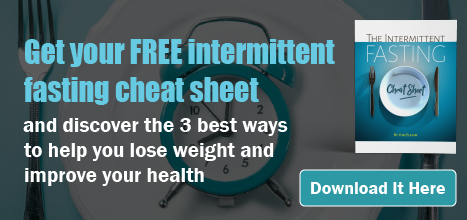In this article
Fasting is a powerful tool that has been recognized for its beneficial health effects for thousands of years. It can reduce blood sugar, improve cholesterol, and even minimize the effects of inflammation. Many people in the modern age appreciate the way that intermittent fasting can be used to accelerate weight loss.
People all around the world are discovering that intermittent fasting, by signaling to the body that it is time to get into a fat burning mode, can increase weight loss in ways that calorie reduction on its own just can’t accomplish. It’s a tool with many uses, so even people whose blood glucose levels are fine or whose cholesterol is ideal can benefit.
Humans love a good hack to make a useful tool even better. If you’re practicing intermittent fasting for weight loss, here are three hacks to help you accelerate that process and tap into your body’s own fat-burning power.
1. Use exercise strategically while fasting
Exercising while fasting requires a hefty dose of common sense and a fasting protocol that makes sense. Fasting and running marathons, for example, do not really mix. There’s a reason why distance runners practice carb-loading before a race! Going into a heavy workout without any caloric intake is a recipe for feeling horrible and poor athletic results.
Sustained exercise is still vital for a healthy lifestyle, of course, but save those workouts (especially the competitive ones where you’re likely to push yourself harder than usual) for days you are not fasting. Your body and your athletic performance will thank you.
So should you give up exercising entirely while fasting? Not at all. The intelligent use of exercise can actually enhance the effectiveness of intermittent fasting for weight loss. If you begin your fasting period in the evening, get up the next morning (around 12 hours into your fasting period) and do 5-10 minutes of high-intensity exercise. This can be anything that makes you breathe hard and gets your heart pumping. Examples of high-intensity activity include:
- Jumping rope
- Calisthenics
- Climbing stairs
- Interval training
- Energetic dancing
But what’s the point of just 5-10 minutes? How can you promote weight loss in such a short period of time? The trick is that you’re not trying this quick bout of exercise on just any day of the week, you’re doing it in the middle of your fasting period. And that makes all the difference.
When you get your heart thumping and your lungs filling, your body releases epinephrine and norepinephrine, which in turn tells your body to release energy from storage, assuming that there must be something dangerous going on to get you to react like that. Your body is smart in a lot of ways, but it doesn’t really know the difference between jumping jacks and a pack of wolves appearing nearby.
This means that for the rest of the morning, your body is not only burning stored fat, it’s doing so more easily since your body just dumped it into your blood as a quick energy source in place of the breakfast it would otherwise be feasting on. Congrats! You’ve just made weight loss one of the simplest things your body can do.
2. Use apple cider vinegar to boost your fast
What should you be consuming during your fast? As a general rule, just water, and herbal (non-caffeinated) tea. When you start drinking things with artificial sweeteners, caffeine, or even calories, the process of fasting becomes confused or interrupted, weakening the health benefits and weight loss power of your fasting period.
Even so, there’s one additive that can be helpful in actually boosting the power of your fast, rather than spoiling it. This is the power of apple cider vinegar.
What is apple cider vinegar? Often shortened to ACV by its fans, apple cider vinegar is made by crushing apples and squeezing out the liquid, which results in the kind of apple cider you find in the juice aisle of the grocery store. Fermenting this turns the sugars into alcohol, resulting in hard cider.
Lastly, a specific type of bacteria is introduced that transform that alcohol into acetic acid, the main ingredient in vinegar. At this point, there is no more alcohol left. Some kinds of apple cider vinegar are then filtered to give it a clear appearance. Others, typically organic varieties, leave the cloudy bits in.
A tablespoonful of apple cider vinegar added to your water has only three calories, and it has been shown to have a positive impact on blood sugar, insulin levels, and feeling satiated, all of which are important elements of fasting and weight loss.
It’s important to note that this doesn’t mean drinking ACV straight from the bottle. While it has many health benefits, it’s also highly acidic, meaning it can be harmful to tooth enamel and the soft tissues of your mouth, throat, and esophagus. A tablespoon in your water is enough to get the full effect. As with fasting itself, it’s important to avoid going overboard.
3. When it comes to fasting, less is more
Intermittent fasting has that name to differentiate it from long-term fasts. You might be familiar with ascetics and religious figures who go days without eating, or while eating very little. This does cause weight loss at first, but at the expense of health. In the end, extreme fasting results in a body that goes into starvation mode, shutting down all but the most urgent functions.
Muscle is lost, metabolism is slowed, and thinking becomes foggy. In some cases, the negative health effects are irreversible, resulting in a chronic illness or even death. Women are particularly prone to negative side effects from extreme fasting, including thyroid and hormonal dysfunction.
So how intermittent should your fasting be? What’s the balance between safety and results?
16-24 hours is all that’s needed to gain the optimal weight loss benefits from fasting. The easiest way to do this is to start your fast after dinner in the evening, continue through the night and morning, and then break your fast with a healthy meal either at lunchtime (for a 16 hour fast) or a late dinner (for 24 hours). The fantastic thing is that you can see the benefits of intermittent fasting by following this schedule just one day a week.
This means you can work fasting into your “rest” day if you’re an athlete or runner. Intermittent fasting, done right, can be a sustainable health practice over the long term, not just a quick weight loss trick to ditch as soon as you’ve hit a goal number.
Ready to hack your weight loss?
Check out the video How to Lose Weight With Intermittent Fasting to learn more about these three fasting hacks and find other videos about how to lose weight in a way that lines up with the way your body actually works. For even better results, download our free Intermittent Fasting Cheat Sheet!


